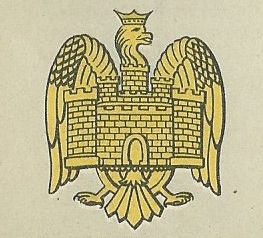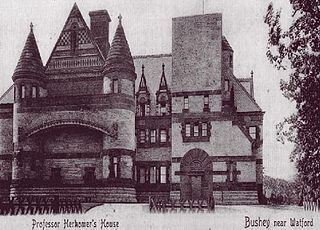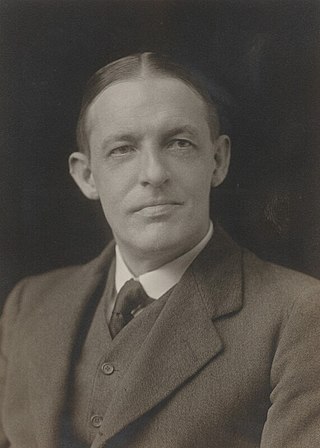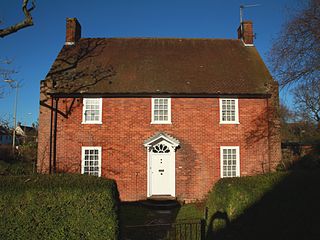
Lancelot "Capability" Brown was an English gardener and landscape architect, a notable figure in the history of the English landscape garden style.

Sir Reginald Theodore Blomfield was a prolific British architect, garden designer and author of the Victorian and Edwardian period.

Edward Russell, 3rd Earl of Bedford was an English nobleman and politician.

Sir Geoffrey Alan Jellicoe was an English architect, town planner, landscape architect, garden designer, landscape and garden historian, lecturer and author. His strongest interest was in landscape and garden design.

Cassiobury House was a country house in Cassiobury Park, Watford, England. It was the ancestral seat of the Earls of Essex. Originally a Tudor building, dating from 1546 for Sir Richard Morrison, it was substantially remodelled in the 17th and 19th centuries and ultimately demolished in 1927. The surrounding Cassiobury Park was turned into the main public open space for Watford.

The Bedfordshire Yeomanry was a Yeomanry regiment of the British Army. Serving intermittently between 1797 and 1827, it was re-raised in 1901 for the Second Boer War. It participated in the First World War before being converted to an artillery regiment. It served in the Second World War. Its lineage was maintained by 201 Battery, 100th (Yeomanry) Regiment Royal Artillery until that unit was placed in suspended animation in 2014.
John Peter Gandy, later John Peter Deering, was a British architect. He served as a member of parliament (MP) from 1847 to 1848.
Sir Brodie Haldane Henderson, KCMG, CB was a British civil engineer. Henderson was primarily a railway engineer who worked for many railroad corporations across South America, Australasia and Africa. He was the consultant for the Dona Ana Bridge which, when it was built in 1935, was the longest railway bridge in the world with a length of 2.24 miles (3.60 km). He volunteered for service with the Royal Engineers at the outbreak of World War I and was put in charge of railway lines used to tranposrt Allied troops and supplies. In this capacity he held the rank of a Brigadier-General of the British Army and his success in this role resulted in him being decorated by the British, French and Belgian governments.

The Hertfordshire Yeomanry was a Yeomanry Cavalry regiment of the British Army that could trace its formation to the late 18th century. First seeing mounted service in the Second Boer War and World War I, it subsequently converted to artillery. Three regiments saw service in World War II, one of which was captured at the fall of Singapore. It continued through various postwar amalgamations and its lineage was maintained by 201 Battery, 100th (Yeomanry) Regiment Royal Artillery until that unit was placed in suspended animation in 2014.

Lululaund was the Romanesque Revival-style house and studio of the Bavarian-born British artist Hubert von Herkomer, in Melbourne Road, Bushey, Hertfordshire. It was designed about 1886 and completed by 1894. The house was demolished in 1939.
Brigadier-General Sir Richard Beale Colvin, was a British officer and Conservative Party politician.

Sir Lawrence Walter William Weaver (1876–1930) was an English architectural writer and civil servant.

Charles Henry Bourne Quennell (1872–1935), was an English architect, designer, illustrator and historian. According to the heritage architect Cath Layton, "his great influence [as an architect and urban planner] can be felt in the houses and streets of London’s suburbs and across the country." His obituary in Nature noted that his books for children and young people had "strongly stimulated interest in the cultural background of the more formal study of history".

Edmund Hort New was an English artist, member of the Birmingham Group, and leading illustrator of his day.
Joseph Clarke (1819–1888) was a British Gothic Revival architect who practised in London, England.
The Hertfordshire Militia was an auxiliary military force in Hertfordshire in South East England. From their formal organisation as Trained Bands in 1558 and their service in the English Civil War, the Militia of Hertfordshire served during times of international tension and all of Britain's major wars. They provided internal security and home defence but sometimes operated further afield, including Ireland, relieving regular troops from routine garrison duties, and acted as a source of trained officers and men for the Regular Army. Under the Cardwell Reforms they were linked with the neighbouring Bedfordshire Regiment and went on active service during the Second Boer War. The Militia were converted into the Special Reserve under the Haldane Reforms of 1908 intended to supply reinforcements to the Regulars. However, the Hertfordshire battalion saw considerable action on the Western Front during World War I, when its commanding officer won a Victoria Cross and it led the final pursuit in the days before the Armistice. After 1921 the militia had only a shadowy existence until its final abolition in 1953.

Thomas Lawrence Dale, FRIBA, FSA was an English architect. Until the First World War he concentrated on designing houses for private clients. From the 1930s Dale was the Oxford Diocesan Surveyor and was most noted for designing, restoring, and furnishing Church of England parish churches.
Arthur Algernon Capell was an English aristocrat who succeed to the title Earl of Essex in 1839.

St Mary's Watford is a Church of England church in Watford, Hertfordshire, in England. It is an active church situated in the town centre on Watford High Street, approximately 25 kilometres (16 mi) outside London. St Mary's is the parish church of Watford and is part of the Anglican Diocese of St Albans. Thought to be at least 800 years old, the church contains burials of a number of local nobility and some noteworthy monumental sculpture of the Elizabethan and Jacobean eras.

Maurice Bingham Adams FRIBA (1849–1933) was a British architect in the Arts and Crafts style.















